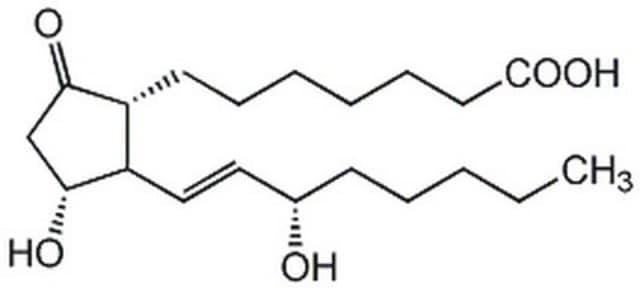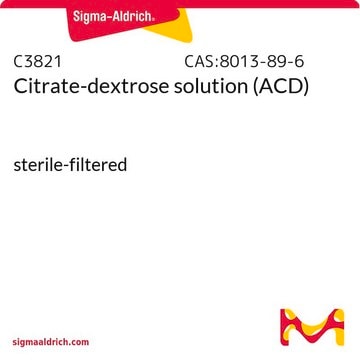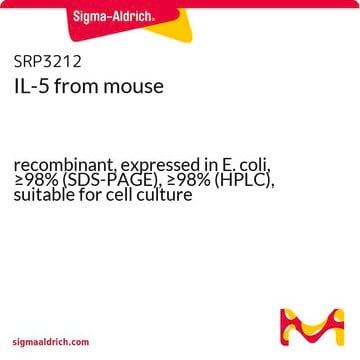Soluble at 50mg/ml, it can be dissolved in water, but it is recommended to use saline, NaCl, DPBS, Hanks, or culture medium. Please note that a reference in peer- reviewed papers at sial.com isolated glomerular endothelial cells at 0.1% in DMEM. This paper may also be of reference "Differential expression of type IV collagen isoforms in rat glomerular endothelial and mesangial cells (https://www.sciencedirect.com/science/article/pii/S0006291X02006939?via%3Dihub)
P5515
Prostaglandin E1
≥98% (HPLC), powder, vasodilator
Synonym(s):
(11α,13E,15S)-11,15-Dihydroxy-9-oxoprost-13-enoic acid, Alprostadil, PGE1
Select a Size
Select a Size
About This Item
Recommended Products
Product Name
Prostaglandin E1, ≥98% (HPLC), synthetic
biological source
synthetic
Assay
≥98% (HPLC)
form
(powder to crystals)
solubility
ethanol: 5 mg/mL
storage temp.
−20°C
SMILES string
O=C1[C@H](CCCCCCC(O)=O)[C@@H](/C=C/[C@H](CCCCC)O)[C@H](O)C1
InChI
1S/C20H34O5/c1-2-3-6-9-15(21)12-13-17-16(18(22)14-19(17)23)10-7-4-5-8-11-20(24)25/h12-13,15-17,19,21,23H,2-11,14H2,1H3,(H,24,25)/b13-12+/t15-,16+,17+,19+/m0/s1
InChI key
GMVPRGQOIOIIMI-DWKJAMRDSA-N
Gene Information
human ... PTGER1(5731) , PTGER2(5732) , PTGIR(5739)
mouse ... Ptger1(19216) , Ptger2(19217) , Ptger3(19218) , Ptger4(19219)
Looking for similar products? Visit Product Comparison Guide
Application
Biochem/physiol Actions
Signal Word
Danger
Hazard Statements
Precautionary Statements
Hazard Classifications
Acute Tox. 3 Oral
Storage Class Code
6.1C - Combustible acute toxic Cat.3 / toxic compounds or compounds which causing chronic effects
WGK
WGK 1
Flash Point(F)
Not applicable
Flash Point(C)
Not applicable
Personal Protective Equipment
Choose from one of the most recent versions:
Already Own This Product?
Find documentation for the products that you have recently purchased in the Document Library.
Customers Also Viewed
Articles
Discover Bioactive Small Molecules for Lipid Signaling Research
-
Is stability in solution information available for the product P5515?
Is stability in solution information available for the product P5515?
1 answer-
Helpful?
-
-
What are the recommended storage temperature conditions for Prostaglandin E1 (P5515) when dissolved in acetone?
1 answer-
The solubility test is designed to ensure the product is free of foreign bodies or other unsoluble substances. Acetone was choosen for the solubility test because appears to have higher solubility in acetone than it does in ethanol. The Quality department will dissolve the product in acetone and discard the solution once the solubility test is complete. So there is no data for what is the preferred storage temperature and length of storage if using acetone as the solvent.
Helpful?
-
Active Filters
Our team of scientists has experience in all areas of research including Life Science, Material Science, Chemical Synthesis, Chromatography, Analytical and many others.
Contact Technical Service










